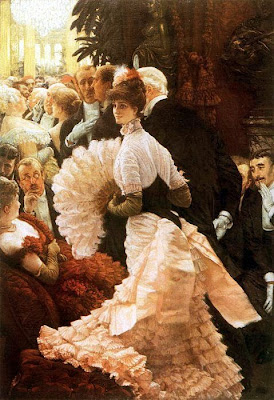Seaside - 1878
The Cleveland Museum of Art - Cleveland - USA
When I discovered James Tissot's (1836-1902) works I was absolutely fascinated by his accurate depictions of the sumptuous fashions of his days. Tissot reveled an enormous interest in painting the upper classes live style, giving his personal interpretation of feminity has he saw it. His paintings are full of looks and poses, strong characters and luminous personalities, ravissant costumes and accessories, full of laces and immaculate colors that fill in all the painting. Both paintings, "Seaside" and "The Reception" depict women as central figures, beautiful, full of light, where viewers glimpse and chat about their rentreé. At the "Seaside" there's a quiet lightning surrounding his model. Is she in the middle of a conversation or just waiting for someone?
 |
| The Reception - 1883-5 |
Born in Nantes, France, Tissot moved to Paris at the age of 20. The artists and writers he met there were to have an enormous influence on his career and his style of painting. He was particularly indebted to James McNeill Whistler, whose work Tissot strongly emulates and surely one of his master Jean-August Ingrès. From Ingrès, Tissot adopted his obsessive attention to detail, developing an enviable technique which gave him an enormous prestige amount the "new rich".
Tissot's interest in fashion helped his works to become highly collectible and they sold well, although critics were less enamored with him than the public.
In 1871, he fled to London, running away from the dangers of the Paris Commune (in which it was rumored he had played a part when he fought at the Franco-Prussian war). His works became as sought after in England as they had been in France, and he exhibited regularly at the Royal Academy.
In London, Tissot studied etching with Sir Seymour Haden, drew caricatures for Vanity Fair, and painted portraits as well as genre subjects.
Sometime in the 1870s Tissot met a divorcee, Mrs. Kathleen Newton, who became his companion and the love of his life, modeling for many of his paintings. Mrs. Newton moved into Tissot's household in 1876 and lived with him until her suicide as a terminal tuberculosis patient, in the late stages of consumption, in 1882, at the age of 28.
The death of Kathleen, spurred him to return to Paris and a second era became evident on his style. Tissot never again painted social events and underwent through a religious conversion, painting only religious scenes. He travelled to the Middle East where he made many sketches, which he worked into illustrations for versions of the Bible.
The death of Kathleen, spurred him to return to Paris and a second era became evident on his style. Tissot never again painted social events and underwent through a religious conversion, painting only religious scenes. He travelled to the Middle East where he made many sketches, which he worked into illustrations for versions of the Bible.
Private Collection
Kathleen Newton is seen here with her children, Cecil George (which was always told it was Tissot's son), Violet (her daughter from her marriage) and her niece Lilian Hervey.
The children, who lived with Kathleen's sister, were frequent visit to Tissot and Kathleen's house, in Grove End Road, which was just some blocks away from her sister's house.


Sem comentários:
Enviar um comentário